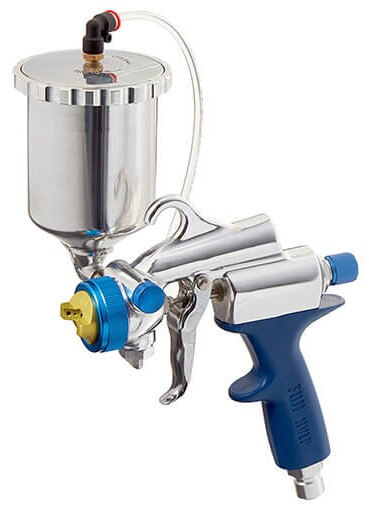What is HVLP paint sprayer?
 HVLP stands for High Volume Low Pressure – a type of sprayer that uses a high volume of air to atomize the paint at low pressure, resulting in a fine mist of paint that can be sprayed onto a surface with greater control and less overspray than conventional spray guns.
HVLP stands for High Volume Low Pressure – a type of sprayer that uses a high volume of air to atomize the paint at low pressure, resulting in a fine mist of paint that can be sprayed onto a surface with greater control and less overspray than conventional spray guns.
HVLP paint sprayers are commonly used for automotive painting, furniture refinishing, and other projects that require a high-quality, professional-looking finish.
Table of Contents
- Reducing Environmental Impact – The Development of HVLP Paint Sprayer Technology
- Types of paints used
- How does spraying with HVLP mechanism work?
- Air compressor and turbine for the HVLP system
- What is HVLP spray gun?
- How to mix paint for HVLP sprayer?
- What applications are HVLP sprayers suitable for?
- Coatings that will not work with HVLP Spray Guns
- Conclusion
Reducing Environmental Impact – The Development of HVLP Paint Sprayer Technology
The HVLP paint sprayer was invented in response to growing concerns about air pollution and environmental regulations related to the use of solvents and volatile organic compounds (VOCs) in traditional spray painting methods.
HVLP technology reduces the amount of overspray and emissions, resulting in a more efficient and environmentally-friendly painting process. It also allows the use of water-based paints, which have lower VOC content compared to traditional solvent-based paints.
Types of paints used
This type of paint sprayer can be used with a variety of paints, including:
- Water-based paints – low-VOC paints that are easy to clean up and offer a more environmentally-friendly alternative to solvent-based paints.
- Oil-based paints – traditional solvent-based paints that offer a durable finish and are commonly used for automotive painting and other industrial applications.
- Latex paints – water-based paints commonly used for interior and exterior house painting.
- Stains and varnishes – used for furniture refinishing and can be applied with an HVLP sprayer for a smooth, even finish.
 How does spraying with HVLP mechanism work?
How does spraying with HVLP mechanism work?
Atomization – The paint is atomized into small droplets as it passes through the spray gun’s nozzle. A combination of high-volume of airflow and low pressure achieves this atomization.
Mixing air (high volume and pressure) and paint (low pressure) – The paint is held in a container and is fed through a tube to the spray gun. As the trigger on the gun is pulled, the air is forced into the gun’s body and mixed with the paint, creating a fine mist that is sprayed onto the surface with minimal overspray.
Smaller droplets for a smooth finish – Because the HVLP sprayer uses lower pressure, there is less overspray than with conventional spray guns, resulting in less wasted paint and a more controlled application. Additionally, the smaller droplets created by the atomization process result in a smoother finish with less texture.
Note – it’s important to use the correct technique when spraying with an HVLP machine, as improper use can result in runs, drips, and other issues.
Air compressor and turbine for the HVLP system
Both air compressors and turbines can be used with HVLP spray guns, but they differ in how they provide the necessary air pressure and volume for atomizing the paint. Some systems use the turbine for the air pressure and the paint.
Air compressor – An air compressor is a machine that compresses air and stores it in a tank until it’s needed. When the air pressure in the tank drops below a certain level, the compressor will automatically turn on and refill the tank. HVLP spray guns can be powered by air compressors, providing the high air volume needed to atomize the paint.
Turbine – On the other hand, a turbine is a self-contained unit that generates the necessary air pressure and volume without needing a separate air compressor. Turbines use a series of fans and electric motors to create the necessary airflow, which is then directed through a hose to the HVLP spray gun.
Choosing between the two types – When choosing between an air compressor and a turbine for an HVLP spray gun, it’s important to consider factors such as the size of the project, the type of paint being used, and the desired finish quality. Air compressors are generally more powerful than turbines and can be used for larger projects and thicker paints, but they can also be noisy and require more maintenance. Turbines are generally quieter and more portable, but they may only be suitable for some projects.
Ultimately, the choice between an air compressor and a turbine depends on personal preference and the project’s specific needs.
What is HVLP spray gun?
 An HVLP spray gun is a paint-spraying tool that uses high volume, low pressure (HVLP) technology to atomize and spray paint onto a surface. This type of gun has a nozzle designed to deliver a fine, uniform spray pattern while using less paint and creating less overspray than traditional spray guns.
An HVLP spray gun is a paint-spraying tool that uses high volume, low pressure (HVLP) technology to atomize and spray paint onto a surface. This type of gun has a nozzle designed to deliver a fine, uniform spray pattern while using less paint and creating less overspray than traditional spray guns.
The HVLP spray gun is typically used for applications that require a high-quality finish, such as automotive painting, furniture refinishing, and other similar projects. It can be used with a variety of paints, including water-based and solvent-based paints.
HVLP spray guns are available in a range of sizes and designs to accommodate different types of projects and paint viscosities. They are typically air-powered and require a compressor to provide the high volume of air needed to atomize the paint.
How important is the gun?
The spray gun is a critical component of the HVLP paint spraying system and plays a vital role in achieving a quality finish. The gun’s design, including the nozzle size, air cap, and needle size, impacts the atomization process and the overall control of the spray pattern.
The quality and performance of the gun can affect the application process, the amount of overspray, the transfer efficiency, and the quality of the finish. A high-quality HVLP spray gun that is properly maintained and adjusted can improve the performance of the spraying system and reduce the amount of paint waste and overspray.
When selecting an HVLP spray gun, it’s important to choose a gun that is designed for the specific type of application and paint being used. It’s also important to follow the manufacturer’s instructions for proper maintenance and cleaning to ensure the gun is operating at its best.
How to mix paint for HVLP sprayer?
Here are some general guidelines when mixing paint for an HVLP sprayer:
- Pour the paint into a mixing container and add any necessary thinners or reducers according to the manufacturer’s instructions.
- Stir the paint and thinners together until well mixed.
- Use a viscosity cup to measure the thickness of the paint. The viscosity should be thin enough to flow through the HVLP spray gun’s nozzle but thick enough to provide good coverage.
- If the paint is too thick, add a small amount of thinner or reducer, and mix well. If the paint is too thin, add a small amount, and mix well.
- Strain the paint through a paint strainer to remove any lumps or debris.
- Pour the mixed paint into the HVLP sprayer’s paint cup, and attach the cup to the gun.
- Adjust the HVLP spray gun’s air pressure, fan pattern, and fluid flow according to your job requirement.
When in doubt, it’s important to follow the manufacturer’s instructions for the specific type of paint being used.
What applications are HVLP sprayers suitable for?
HVLP sprayers are suitable for a wide range of applications, including:
- Painting furniture – HVLP spray guns are commonly used to paint furniture, such as tables, chairs, and cabinets. The guns provide a fine mist of paint that can be easily applied to flat and curved surfaces, resulting in a smooth and even finish.
- Automotive painting – HVLP spray guns are also used in the automotive industry for painting cars, trucks, and other vehicles. The guns can apply a uniform coat of paint that produces a high-quality finish with minimal overspray.
- DIY home projects – HVLP spray guns are popular for DIY home projects, such as painting walls, ceilings, and other surfaces. The guns can provide a smooth and even finish that is difficult to achieve with traditional brushes or rollers.
- Industrial coatings – HVLP spray guns are also used in industrial applications for coating metal parts, machinery, and other equipment. The guns can apply a consistent and precise coat of paint or other coatings, resulting in a durable and long-lasting finish.
Overall, HVLP spray guns are suitable for any application that requires a smooth and even coat of paint or other coatings, with minimal overspray and waste.
Coatings that will not work with HVLP Spray Guns
While HVLP spray guns can be used with a wide variety of coatings, some coatings may not work well with this type of equipment. Some coatings that may not be suitable for use with HVLP spray guns include:
- High-viscosity coatings: HVLP spray guns are designed to work with low-to-medium viscosity coatings, so high-viscosity coatings such as heavy epoxies or rubberized coatings may not work well with this type of equipment.
- Textured coatings: HVLP spray guns are not recommended for spraying textured coatings such as popcorn or knockdown textures, as these coatings require a heavier spray pattern than what HVLP spray guns can provide.
- Rust-proofing coatings: Rust-proofing coatings are often high-viscosity and contain heavy solids, which can clog the small nozzle of an HVLP spray gun.
- Adhesives: Some adhesives may not work well with HVLP spray guns, as they require specialized equipment to ensure even coverage and proper adhesion.
In general, it’s important to choose coatings specifically designed for use with HVLP spray guns and follow the manufacturer’s instructions for the specific coating being used. This will help ensure that you achieve the best results with your HVLP spray gun and avoid any issues with clogging or uneven coverage.
Conclusion
The HVLP paint sprayer was invented in response to growing concerns about air pollution and environmental regulations related to the use of solvents and volatile organic compounds in traditional spray painting methods. The technology used by HVLP sprayers reduces overspray and emissions, resulting in a more efficient and environmentally-friendly painting process.
An HVLP spray gun is an essential component of the HVLP paint spraying system, and selecting the right gun for the project can improve the quality and efficiency of the spraying process.
HVLP spray guns can be powered by either an air compressor or a turbine and are suitable for a wide range of applications, including furniture painting, automotive painting, DIY home projects, and industrial coatings.
When mixing paint for an HVLP sprayer, follow the manufacturer’s instructions for the specific type of paint being used, and practice on a test surface before beginning your project.

